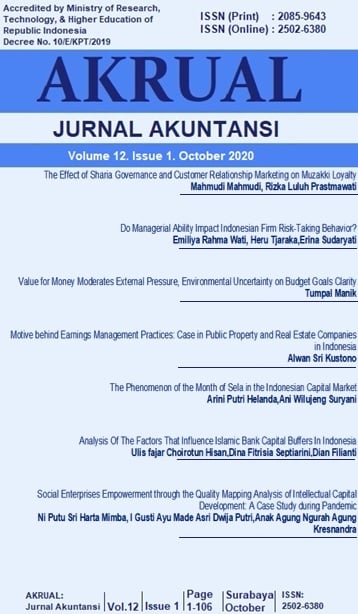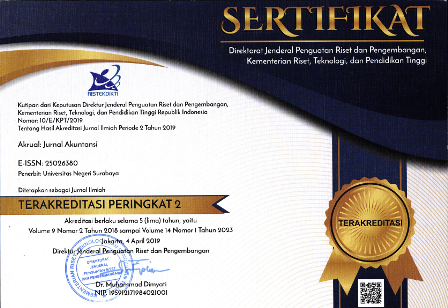The Phenomenon of the Month of Sela in the Indonesian Capital Market
DOI:
https://doi.org/10.26740/jaj.v12n1.p65-79Keywords:
Seasonal Anomalies, Sela, Mean Return, Conditional Volatility, JavaneseAbstract
Seasonal anomalies cause market inefficiency by affecting the mean and volatility of stock returns, and allow investors to obtain abnormal returns. In Indonesia, there is the month of Sela which is believed as an unlucky month so that many people avoid this month to hold ceremonial activities. As a result, the economy declines in the month of Sela and possibly, the return will also drop in this month. Therefore, this research aims to reveal whether the month of Sela is a seasonal anomaly. This research tested two hypotheses; the effect of the mean and volatility of price index return by using the GARCH model. To examine the effect of the month of Sela on the mean and volatility of return of price index, we collected the data on Indonesian Composite Index and 10 sectoral indices from 2009 to 2019 on three Javanese months, Sawal, Selo and Besar. In total, we collected 7.095 returns data. The month of Sela was a seasonal anomaly that the average and volatility of returns during the month of Sela were lower than those during the months of Sawal and Besar. These results also indicated that during the months of Sawal and Besar, the price index was more volatile than it was during the month of Sela. This research is useful for investors in considering their investment decisions to obtain an abnormal return. This research also contributes to the literature by adding new knowledge about seasonal anomalies that exist in Indonesia.
References
Al-Khazali, O. (2014). Revisiting Fast Profit Investor Sentiment and Stock Returns During Ramadan. International Review of Financial Analysis.
Anderson, B. R. O. (2009). Mythology and The Tolerance of The Javanese. United Kingdom UK: Equinox Publishing.
Badan Pusat Statistik. (2015, November 18). Mengulik Data Suku di Indonesia. Badan Pusat Statistik. Retrieved from: https://www.bps.go.id/news/2015/11/18/127/mengulik-data-suku-di-indonesia.html
Burton, E. T., & Shah, S. N. (2013). Behavioral Finance: Understanding The Social, Cognitive, and Economic Debates. Wiley.
Geertz, C. (1976). The Religion of Java. Chocago: University of Chicago Press.
Halari, A. (2017). Calendar Anomalies in Pakistani Stock Returns and Return Volatility. European Journal of Economics.
Halari, A., Helliar, C., Power, D. M., & Tantisantiwong, N. (2018). Taking Advantage of Ramadan and January in Muslim countries. Quarterly Review of Economics and Finance.
Hamdi, A. (2018, July 5). Fenomena Bulan Selo 1439 H. Retrieved from: www.harianmerdekapost.com/2018/07/fenomena-bulan-selo-1439-h.html
Hermin, S., & Mahadwartha, P. A. (2018). Javanese lunar calendar effect (Primbon) on abnormal return. Advances in Social Science, Education and Humanities Research, 186.
Mulder, N. (1994). The Ideology of Javanese - Indonesian Leadership. Curzon Press.
Munusamy, D. (2019). Does Ramadan Influence The returns and Volatility? Evidence from Shariah Index in India. Journal of Islamic Accounting and Bussiness Research.
Rohmatillah, M. (2019, July 24). Begini Dampak Musim Kemarau dan Bulan Selo Terhadap Harga Bahan Pokok di Lamongan. Retrieved from: www.timesindonesia.co.id/read /news/221941/begini-dampak-musim-kemarau danbulan-selo-terhadap-harga-bahan-pokok-di-lamongan
Shahid, M. N., Sattar, A., Aftab, F., Saeed, A., & Abbas, A. (2019). Month of Ramadan Effect Swings and Market Becomes Adaptive: A Firm Level Evidence Through Islamic Calendar. Journal of Islamic Marketing.
Uchoa, P. (2018, September 17). Krisis ekonomi 2008 dan keadaannya di sejumlah negara, termasuk Indonesia, 10 tahun kemudian. Retrieved from: BBC.Com. https://www.bbc. com/indonesia/dunia-45495304
Wahyudi, M. Z. (2014, November 6). Kalender Jawa, Akulturasi Budaya Islam-Hindu. Retrieved from: https://sains.kompas.com/read/2014/11/06/20363101/Kalender.Jawa. Akulturasi.Budaya.Islam-Hindu.?page=all#page4.
Woodward, M. R. (1989). Islam in Java: Normative Piety and Mysticism in The Sultanate of Yogyakarta. Arizona: University of Arizona Press.
World Population Review. (2020, February 20). Muslim Population by Country 2020. Retrieved from: http://worldpopulationreview.com/countries/muslim-population-by country/
Downloads
Additional Files
Published
How to Cite
Issue
Section
License
Copyright (c) 2020 AKRUAL: Jurnal Akuntansi

This work is licensed under a Creative Commons Attribution-NonCommercial 4.0 International License.
 Abstract views: 808
,
Abstract views: 808
, PDF Downloads: 866
,
PDF Downloads: 866
, PDF Downloads: 0
,
PDF Downloads: 0
, PDF Downloads: 0
PDF Downloads: 0


















